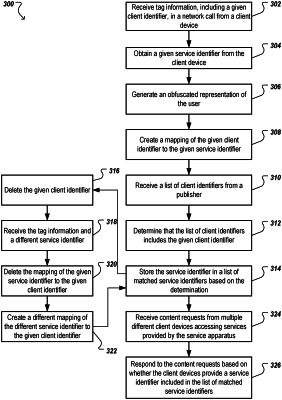| CPC H04L 67/14 (2013.01) [G06F 21/31 (2013.01); H04L 63/10 (2013.01); H04L 67/02 (2013.01)] | 20 Claims |

|
1. A method, comprising:
receiving, by a service apparatus, tag information in a network call to the service apparatus by a client device of a user, the tag information specifying a given client identifier that (i) is assigned to user by a publisher that differs from each of (a) the service apparatus and (b) the user, and (ii) represents the user in a publisher domain of the publisher, wherein the publisher domain is a second level Internet domain in which documents of the publisher are accessed by the client device;
obtaining, by the service apparatus, a given service identifier that (i) is assigned to the user by the service apparatus, (ii) differs from the given client identifier; and (iii) represents the user in a service domain of the service apparatus, wherein the service domain differs from the publisher domain and is a second level Internet domain in which documents of the service apparatus are accessed by the client device;
creating, by the service apparatus and in a data structure, a mapping of the given service identifier to the given client identifier;
receiving, by the service apparatus, multiple content requests from multiple different client devices accessing services provided by the service apparatus in the service domain; and
responding to the content requests based on whether the client devices provide service identifiers that are mapped to the given client identifier, including:
transmitting first content reserved for content requests from client devices that provide service identifiers that are mapped to the given client identifier assigned to the user by the publisher when the content request includes a service identifier that is mapped to the given client identifier; and
transmitting second content that is not reserved for the content requests from client devices that provide service identifiers that are mapped to the given client identifier assigned to the user by the publisher when the content request does not include a service identifier that is mapped to the given client identifier.
|